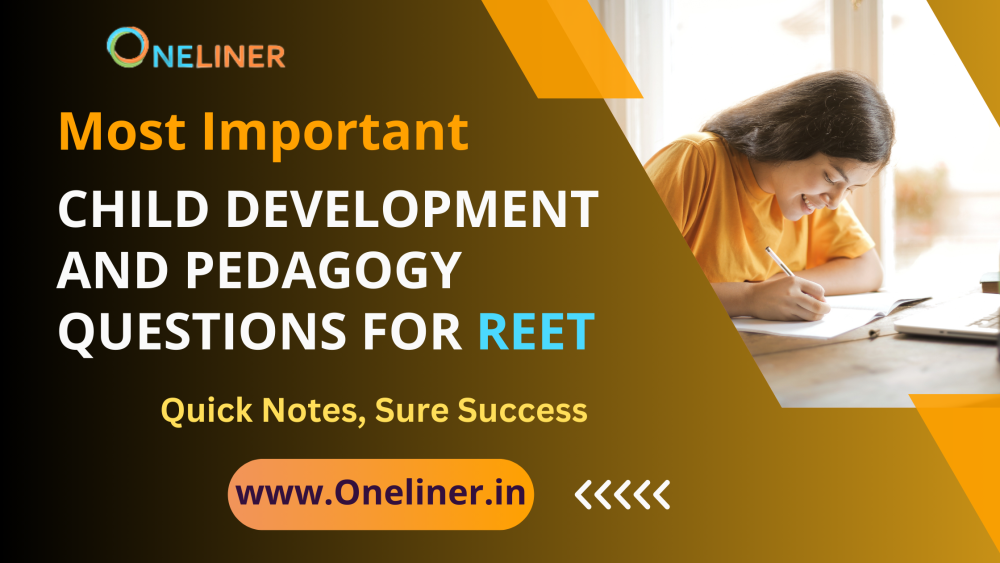 onelinerinfo@gmail.com
onelinerinfo@gmail.com
Home | About Us | Contact Us
Home | About Us | Contact Us

The Board of Secondary Education, Rajasthan conducts Rajasthan Teacher Eligibility Test (RTET). The State level RTET exam is conducted for the recruitment of Level 1 or Primary Teachers and Level 2 or Upper Primary Teachers.
Child development & pedagogy (CDP) is very important section in this exam. Here we listed some important child development & pedagogy questions and answers for REET exam.
|
Q 31.
The various aspects such as language, technology, economic system, education and various aspects of human civilisation etc.are collectively called as ?
Ans.
Biophysical environment
|
|
Q 32.
Demonstrating close to real life situation is possible through which ?
Ans.
Stimulated learning
|
|
Q 33.
What do children need to learn when they acquire a language ?
Ans.
Phonology,lexicon , grammar and pragmatics
|
|
Q 34.
Which technology aided learning methods could be a good substitute for a field trip ?
Ans.
Interactive learning programme
|
|
Q 35.
Use of educational technology is a advantageous over many other methods because ?
Ans.
It provide wider range of sensory involvement
|
|
Q 36.
Who is regarded the father of Demonstrative Geometry ?
Ans.
Euclid
|
|
Q 37.
What is the academic style of language expected in the classroom context ?
Ans.
Interpersonal stance ( discussion and negotiation in the class )
|
|
Q 38.
West's method aims at the development of __________which is an essential and salient feature of language learning ?
Ans.
Vocabulary
|
|
Q 39.
How does technology help a teacher in improving teaching ?
Ans.
AV recording and reflecting on teaching
|
|
Q 40.
"Teaching is done in a practical manner which is systematically worked out." Which lentils corresponds to the statement ?
Ans.
Meaningful approach
|
|
Q 41.
Which is NOT the characteristic of educational technology ?
Ans.
It makes the teaching process monotonous
|
|
Q 42.
What is the use of a big book in the classroom ?
Ans.
It helps the children to engage and actively discuss what they think the story is going to be
|
|
Q 43.
What is the full form of STM ?
Ans.
Phonological short- term memory
|
|
Q 44.
Who is the most influential exponent of cognitivism ?
Ans.
Jean Piaget
|
|
Q 45.
"Puzzles are also called as brain teasers." Puzzles in mathematics help students in a math class to ?
Ans.
Develop power of thinking and reasoning in the students.
|
|
Q 46.
In Psychoanalysis theory of Freud, "ID" refers to ?
Ans.
Unconscious in nature and has no direst contact with reality
|
|
Q 47.
Which is NOT carried out in Post- Active phase of teaching ?
Ans.
Setting of educational objective
|
|
Q 48.
One teaching approach is to use a mental map. It is used when which is a part of educational philosophy ?
Ans.
Rationalism
|
|
Q 49.
Gender diversity means ?
Ans.
Equal ratio of males and females
|
|
Q 50.
One of the factors which obstruct learning is ?
Ans.
Egoistic feeling
|
|
Q 51.
Techniques for fostering creativity in children include ?
Ans.
Concept presentation, Problem solving, Group discussion
|
|
Q 52.
What is the correct sequence of steps in affective domain of learning ?
Ans.
Receiving -> Responding -> Valuing -> Organisation -> Characterization
|
|
Q 53.
In project method of teaching, the role of teacher is _________?
Ans.
Friend, Philosopher and Guide
|
|
Q 54.
Which is NOT a part of motivation process ?
Ans.
Heredity
|
|
Q 55.
Which are important elements of achievement motivation of students ?
Ans.
Home environment, School environment and Social environment
|
|
Q 56.
In inclusive term, exceptional children means ?
Ans.
The gifted intelligent, backward, mentally retarded children
|
|
Q 57.
Who is the father of child psychology ?
Ans.
Stanley Hall
|
|
Q 58.
Chomsky's theory of language development helps language teachers because he believes that ?
Ans.
Children are born with an inherent ability to learn any human language
|
|
Q 59.
What do you understand by Piaget's sensorimotor stage ?
Ans.
Children learn about the world through their senses.
|
|
Q 60.
What do you understand by memory in the cognitive domain ?
Ans.
Recalling or retrieving previously learned information
|